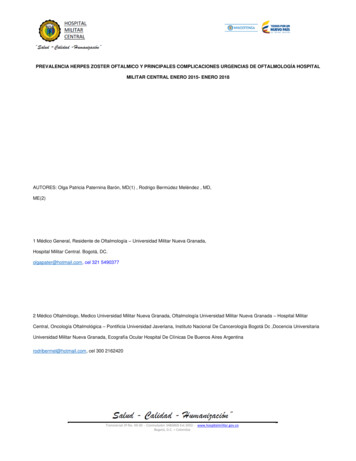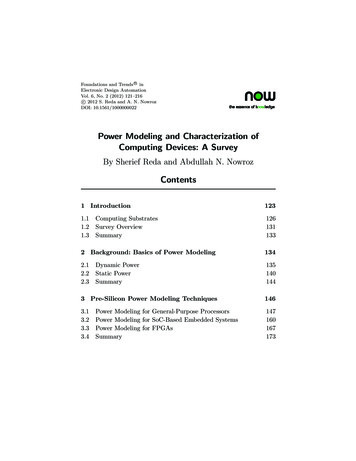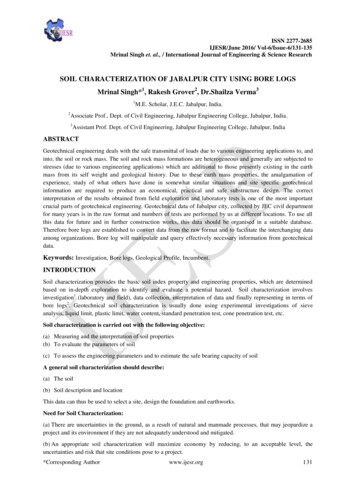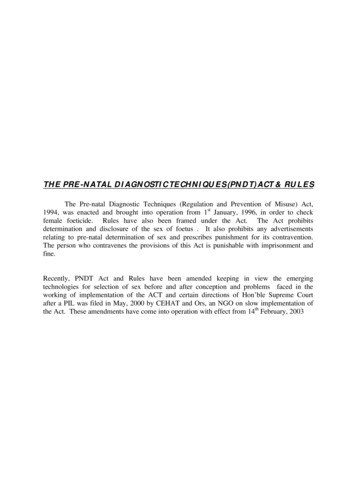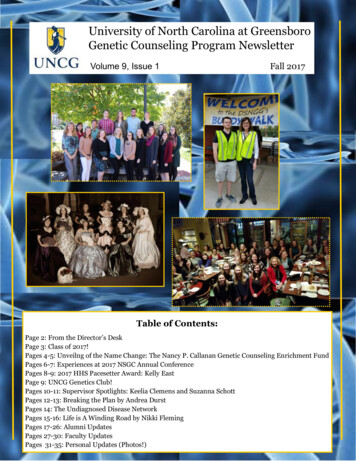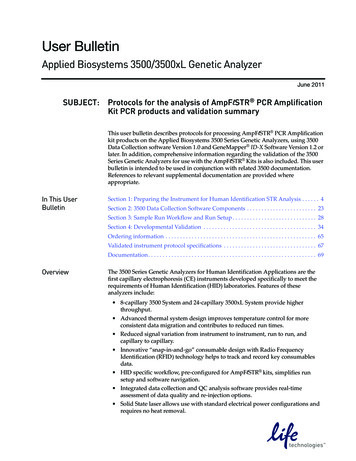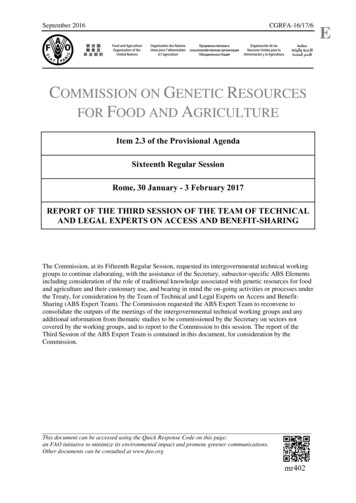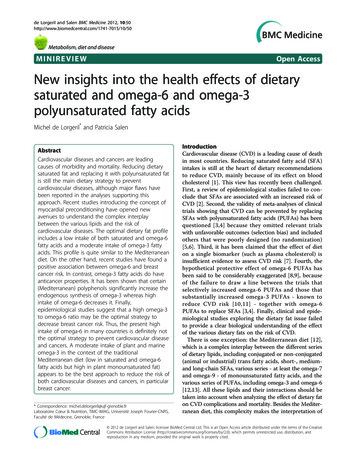
Transcription
(2022) 19:122El‑Duah et al. Virology pen AccessCASE REPORTGenetic characterization of varicella‑zosterand HIV‑1 viruses from the cerebrospinal fluidof a co‑infected encephalitic patient, GhanaPhilip El‑Duah1* , Augustina Angelina Sylverken2,3, Michael Owusu2,4, Yaw Ampem Amoako2,5,7,Richmond Yeboah2, Richmond Gorman2, Emmanuella Nyarko‑Afriyie2, Julia Schneider1, Terry C. Jones1,6,Joseph Bonney7, Titus Adade7, Eric Smart Yeboah7, Tabea Binger2, Victor Max Corman1, Christian Drosten1* andRichard Odame Phillips2,5*AbstractBackground: Encephalitis is a serious disease of the brain characterized by prodromal and specific neurologicalsymptoms. HIV infections offer opportunistic viruses, such as Varicella-zoster virus (VZV), the chance to cause enceph‑alitis in patients. There is a lack of information on the genetic diversity of VZV in Ghana and other parts of Africa whichrequires sequencing and characterization studies to address. The active evolution of HIV-1 in West Africa also requirescontinuous surveillance for the emergence of new genetic forms.Case presentation: VZV was detected in the CSF sample of an 11-year-old patient presenting with symptoms ofencephalitis by real-time PCR diagnostics. To identify possible unknown aetiological pathogens, next-generationsequencing was performed, and revealed an HIV-1 co-infection.Alignments of concatenated HIV-1 genome fragments in the gag, pol, vif, env and nef regions and a near-completeVZV genome were analyzed by Bayesian inference, and phylogenetic trees were generated. The VZV sequencebelongs to clade 5 and the HIV-1 sequence is a member of the CRF02 AG predominant circulating recombinant formin Ghana.Conclusions: Diagnostic tests for CSF HIV would be useful where possible in patients presenting with encephalitisdue to VZV and other opportunistic viruses in Kumasi to shed light on the role of HIV in encephalitis cases in Ghana.This report reaffirms the role of the CRF02 AG circulating recombinant form in HIV infections in Ghana and also givesa preliminary genetic characterization of VZV in Kumasi, Ghana.Keywords: Varicella-zoster virus, Chickenpox, HIV, Coinfection, Encephalitis, Ghana*Correspondence: philip.el-duah@charite.de; itute of Virology, Charité - Universitätsmedizin Berlin, Corporate Memberof Freie Universität Berlin, Humboldt-Universität Zu Berlin, and Berlin Instituteof Health, Berlin, Germany2Kumasi Centre for Collaborative Research Into Tropical Medicine, KwameNkrumah University of Science and Technology, Kumasi, GhanaFull list of author information is available at the end of the articleBackgroundEncephalitis is a serious disease of the brain characterized by prodromal and specific neurological symptoms[1]. Among the most common viral causes of encephalitis known worldwide are Herpes simplex viruses(HSV), Varicella zoster viruses (VZV), and Enteroviruses [2]. Certain viruses can be opportunistic and takeadvantage of weakened immunity to cause encephalitis[3]. Human immunodeficiency virus (HIV) infections The Author(s) 2022. Open Access This article is licensed under a Creative Commons Attribution 4.0 International License, whichpermits use, sharing, adaptation, distribution and reproduction in any medium or format, as long as you give appropriate credit to theoriginal author(s) and the source, provide a link to the Creative Commons licence, and indicate if changes were made. The images orother third party material in this article are included in the article’s Creative Commons licence, unless indicated otherwise in a credit lineto the material. If material is not included in the article’s Creative Commons licence and your intended use is not permitted by statutoryregulation or exceeds the permitted use, you will need to obtain permission directly from the copyright holder. To view a copy of thislicence, visit http:// creat iveco mmons. org/ licen ses/ by/4. 0/. The Cre 99.99%. The sequence was submitted to GenBank andassigned accession number OL311042. Phylogeneticanalysis showed the sequence to belong to clade 5 whichis predominant in Africa (Fig. 1). A recombination eventwas detected in the sequence by RDP4 which was sharedby several other sequences in clade 5 and statistically supported as determined by the GENECONV (p 0.0157),MaxChi (p 0.001) and Chimaera (P 0.0121) methods.There was no major parent identified for this recombination event and may suggest this sequence to be part of arecombinant lineage within the clade with an unknownancient common ancestor.HIV classificationHIV-1 sequence fragments obtained in the study wererelated in varying degrees to a variety of circulatingrecombinant forms with as high as 100% identity in thepolymerase gene region (CRF02 AG, Nigeria) and thenef gene region (CRFA6, Ukraine) and as low as 77.1% inthe envelope glycoprotein gene region (CRFC, Ethiopia).The phylogenetic analysis of the concatenated alignmentshowever found the sequence to cluster with a CRF02 AGcirculating recombinant form from Nigeria (Fig. 2). TheCRF02 has been found in previous studies to be the dominant strain circulating in Ghana [7, 8]. Sequence data ofthe short HIV-1 fragments used in this analysis can befound in Additional file 1: Table S1.Discussion and conclusionsAccurate diagnosis of CNS infections is essential fortimely treatment and improved chances of survival.However, many obstacles hinder accurate diagnoses particularly in resource-limited settings where HIV is alsoendemic, chief among them the limited availability of laboratory diagnostic tests as well as treatments [19]. In particular, the importance of viral diagnostics becomes moreevident in the absence of bacterial etiological agents afterroutine analysis of CSF following a suspected CNS infection as was the case for the patient in this report.In settings where opportunistic CNS infections aredetected especially in HIV endemic regions, screeningfor HIV in CSF may be useful. Without accurate diagnoses in the event of co-infection, challenges in treatmentoccur such as targeted elimination of the detected aetiological agent without consideration of the underlyingHIV infection, leading to a poor prognosis. Even in theevent of a known prior history of HIV infection and ARTtreatment, lack of CSF detection as an indicator of compartmentalization and resistance to therapy may hinderconsiderations for treatment options [20].During HIV infection, analysis of CSF has been foundto be useful for the detection of opportunistic infections like VZV and other co-infections as well as the
El‑Duah et al. Virology Journal(2022) 19:122Page 4 of 6Fig. 1 Phylogenetic placement of VZV sequence from co-infected CSF sample. Sequence alignments were done using the MAFFT algorithmand with other sequences from GenBank. Phylogenetic analysis was performed by Bayesian inference using the GTR G I substitution model.Sequences in the tree are designated by GenBank accession numbers and origins in brackets with the sequence from this study shown in a redfont. Posterior probability support values are indicated at the nodes in the unrooted tree (A) and values greater than 0.9 are indicated in the rootedtree by black dots (B)quantification of HIV viral load in CSF as an indicator fortreatment failure and CNS compartmentalization [21].However, CSF tests and viral load quantification for HIVin encephalitis is not commonly done in the local settingalthough this would be useful where possible in HIVpositive patients to shed more light on the role of HIV inencephalitis cases.The VZV sequence obtained in this report unsurprisingly clustered with other clade 5 sequences in line withthe predominance of this clade in the African region [13].A study that investigated VZV viruses from various bodycompartments found a higher diversity of viruses withinCSF from encephalitis patients and hypothesized this tobe a result of reactivation from multiple neurons possiblyfollowing reinfection and latency with a different strain[14]. This may be likely in areas with high migrationfrom different geographical locations with accompanying different virus strains. Further studies with sufficientCSF-derived VZV strains from different regions will berequired to provide a clearer understanding.Shared recombination events within subsets ofsequences within clades as seen in this report may suggest such lineages descended from recombinant parentsas suggested by Norbet et al. who assumed this to be thecase for intraclade recombination crossovers [22]. Thismay be useful in further understanding the epidemiologyof circulating VZV strains.The sequence identity of the various sequence fragments in this report hints at a complex recombination history of the detected HIV-1 virus although thesequence appears to belong to the predominant CRF02AG circulating recombinant form. This does not obviatethe need for continuous surveillance to monitor geneticchanges that may affect laboratory diagnostics andtreatment.The result of this report provides a useful preliminary genetic characterization of a VZV virus in Kumasi,Ghana and its co-infecting HIV-1 Virus in an encephalitic patient.
El‑Duah et al. Virology Journal(2022) 19:122Page 5 of 6Fig. 2 Phylogenetic comparison of circulating recombinant forms of HIV-1. Sequence alignments were done using the MAFFT algorithm and aconcatenation of alignments of partial sequences from the gag, pol, vif, env and nef regions with other sequences from GenBank. Sequences inthe tree are designated by GenBank accession numbers and assigned CRF, with the sequence from this study depicted by a red font. Black dotsrepresent notes with posterior probability of 0.90 or greater and white dots represent those greater than 0.75AbbreviationsADC: AIDS dementia complex; AIDS: Acquired immunodeficiency syndrome;CNS: Central nervous system; CRF: Circulating recombinant form; CSF: Cer‑ebrospinal fluid; GCS: Glasgow coma score; HIV: Human immunodeficiencyvirus; HSV: Herpes simplex virus; HTS: High-throughput sequencing; KCCR : Kumasi centre for collaborative research into tropical medicine; MAFFT:Multiple alignment using fast fourier transform; NCBI: National center for bio‑technology information; PCR: Polymerase chain reaction; RDP4: Recombina‑tion detection program version 4; RDT: Rapid diagnostic test; RNA: Ribonucleicacid; URF: Unique recombinant form; US: United States; VZV: Varicella zostervirus; WBC: White blood cells.Supplementary InformationThe online version contains supplementary material available at https:// doi. org/ 10. 1186/ s12985- 022- 01854-7.Additional file 1. Table S1. FASTA sequences of HIV-1 fragments used inphylogenetic analysis.AcknowledgementsNot applicable.
El‑Duah et al. Virology Journal(2022) 19:122Page 6 of 6Author contributionsPE-D conducted lab experiments and analyzed data. PE-D and YAA drafted themanuscript. AAS, MO and TB coordinated diagnostic laboratory testing anddata acquisition. RY, RG and EN-A performed diagnostic laboratory testing. JSand TCJ performed HTS and downstream data analysis. YAA, JB, TA and ESYperformed sample collection and data acquisition. AAS, VMC, RP and CD con‑ceptualized the study. RP and CD acquired funding. All authors read, reviewedand approved the content of the manuscript.6.FundingOpen Access funding enabled and organized by Projekt DEAL. This publicationis part of the PANDORA-ID-NET (EDCTP Reg/Grant RIA2016E-1609), funded bythe European and Developing Countries Clinical Trials Partnership (EDCTP2)programme which is supported under Horizon 2020, the European Union’sFramework Programme for Research and Innovation. The views and opinionsof authors expressed herein do not necessarily state or reflect those of EDCTP.9.7.8.10.11.Availability of data and materialsAll data generated or analysed during this study are available online in pub‑licly available repositories or included in this published article or supplemen‑tary files.12.Declarations13.Ethics approval and consent to participateEthical approval for this study was obtained from the Committee on HumanResearch, Publications and Ethics of the School of Medical Sciences, KwameNkrumah University of Science and Technology (KNUST) and the KomfoAnokye Teaching Hospital, Kumasi (CHPRE/AP/462/19).14.15.Consent for publicationWritten informed consent was obtained from the legal guardian of the patientfor publication of this case report.16.Competing interestsThe authors declare they have no competing interests.17.Author details1Institute of Virology, Charité - Universitätsmedizin Berlin, Corporate Memberof Freie Universität Berlin, Humboldt-Universität Zu Berlin, and Berlin Instituteof Health, Berlin, Germany. 2 Kumasi Centre for Collaborative Research IntoTropical Medicine, Kwame Nkrumah University of Science and Technology,Kumasi, Ghana. 3 Department of Theoretical and Applied Biology, KwameNkrumah University of Science and Technology, Kumasi, Ghana. 4 Departmentof Medical Diagnostics, College of Health Sciences, Kwame Nkrumah Univer‑sity of Science and Technology, Kumasi, Ghana. 5 Department of Medicine, Col‑lege of Health Sciences, Kwame Nkrumah University of Science and Technol‑ogy, Kumasi, Ghana. 6 Department of Zoology, Centre for Pathogen Evolution,University of Cambridge, Downing St, Cambridge CB2 3EJ, UK. 7 Departmentof Medicine, Komfo Anokye Teaching Hospital, Kumasi, Ghana.18.19.20.21.Received: 10 December 2021 Accepted: 15 July 202222.References1. Tyler KL. Acute viral encephalitis. N Engl J Med. 2018;379(6):557–66.2. Boucher A, Herrmann J, Morand P, Buzelé R, Crabol Y, Stahl J, et al. Epide‑miology of infectious encephalitis causes in 2016. Medecine et MaladiesInfectieuses. 2017;47(3):221–35.3. Solomon T, Hart IJ, Beeching NJ. Viral encephalitis: a clinician’s guide. PractNeurol. 2007;7(5):288–305.4. Peluso MJ, Ferretti F, Peterson J, Lee E, Fuchs D, Boschini A, et al. Cerebro‑spinal fluid HIV escape associated with progressive neurologic dysfunc‑tion in patients on antiretroviral therapy with well-controlled plasma viralload. AIDS (London, England). 2012;26(14).5. Price RW, Spudich S. Antiretroviral therapy and central nervous systemHIV type 1 infection. The J Infect Dis. 2008;197(Supplement 3):S294-S306.Thomson MM, Nájera R. Molecular epidemiology of HIV-1 variants in theglobal AIDS pandemic: an update. AIDS Rev. 2005;7(4):210–24.Delgado E, Ampofo WK, Sierra M, Torpey K, Pérez-Álvarez L, Bonney EY,et al. High prevalence of unique recombinant forms of HIV-1 in Ghana:molecular epidemiology from an antiretroviral resistance study. JAIDS JAcquir Immun Defic Syndr. 2008;48(5):599–606.Fischetti L, Opare-Sem O, Candotti D, Sarkodie F, Lee H, Allain JP. Molecu‑lar epidemiology of HIV in Ghana: dominance of CRF02 AG. J Med Virol.2004;73(2):158–66.Loparev VN, Gonzalez A, Deleon-Carnes M, Tipples G, Fickenscher H, Tor‑fason EG, et al. Global identification of three major genotypes of varicellazoster virus: longitudinal clustering and strategies for genotyping. J Virol.2004;78(15):8349–58.Lizzi J, Hill T, Jakubowski J. Varicella zoster virus encephalitis. Clin PractCases Emerg Med. 2019;3(4):380–2.Breuer J, Grose C, Norberg P, Tipples G, Schmid DS. A proposal for acommon nomenclature for viral clades that form the species varicellazoster virus: summary of VZV nomenclature meeting 2008, barts and theLondon school of medicine and Dentistry, 24–25 July 2008. J Gen Virol.2010;91(Pt 4):821.Jensen NJ, Rivailler P, Tseng HF, Quinlivan ML, Radford K, Folster J, et al.Revisiting the genotyping scheme for varicella-zoster viruses based onwhole-genome comparisons. J Gen Virol. 2017;98(6):1434–8.Breuer J. Molecular Genetic Insights into varicella zoster virus (VZV), thevOka vaccine strain, and the pathogenesis of latency and reactivation. JInfect Dis. 2018;218(suppl 2):S75-s80.Depledge DP, Cudini J, Kundu S, Atkinson C, Brown JR, Haque T, et al. Highviral diversity and mixed infections in cerebral spinal fluid from cases ofvaricella zoster virus encephalitis. J Infect Dis. 2018;218(10):1592–601.Falcone EL, Adegbulugbe AA, Sheikh V, Imamichi H, Dewar RL, HammoudDA, et al. Cerebrospinal fluid HIV-1 compartmentalization in a patientwith AIDS and acute varicella-zoster virus meningomyeloradiculitis. ClinInfect Dis. 2013;57(5):e135–42.Almeida SMd. Cerebrospinal fluid analysis in the HIV infection andcompartmentalization of HIV in the central nervous system. Arquivos deneuro-psiquiatria. 2015;73(7):624–9.Huelsenbeck JP, Ronquist F. MRBAYES: Bayesian inference of phylogenetictrees. Bioinformatics. 2001;17(8):754–5.Leitner T, Korber B, Daniels M, Calef C, Foley B. HIV-1 subtype and circulat‑ing recombinant form (CRF) reference sequences, 2005. HIV sequencecompendium. 2005;2005:41–8.Leligdowicz A, Katwere M, Piloya T, Ronald A, Kambugu A, Katabira E.Challenges in diagnosis, treatment and follow-up of patients present‑ing with central nervous system infections in a resource-limited setting.McGill J Med MJM Int Forum advancement of medical sciences bystudents. 2006;9(1):39–48.Antinori A, Cingolani A, Giancola ML, Forbici F, De Luca A, Perno CF. Clini‑cal implications of HIV-1 drug resistance in the neurological compart‑ment. Scand J Infect Dis Suppl. 2003;106:41–4.Tyler KL, McArthur JC. Through a glass, darkly: cerebrospinal fluid viralload measurements and the pathogenesis of human immunode‑ficiency virus infection of the central nervous system. Arch Neurol.2002;59(6):909–12.Norberg P, Depledge DP, Kundu S, Atkinson C, Brown J, Haque T, et al.Recombination of globally circulating varicella-zoster virus. J Virol.2015;89(14):7133–46.Publisher’s NoteSpringer Nature remains neutral with regard to jurisdictional claims in pub‑lished maps and institutional affiliations.
cally stable and dierent genotyping approaches have been used including single nucleotide polymorphism typing and whole genome sequencing [11], however clas-sication is currently via international consensus, pres - ently consisting of seven established clades (designated 1-6 and 9) and two putative clades (designated VII and VIII) [1211].
